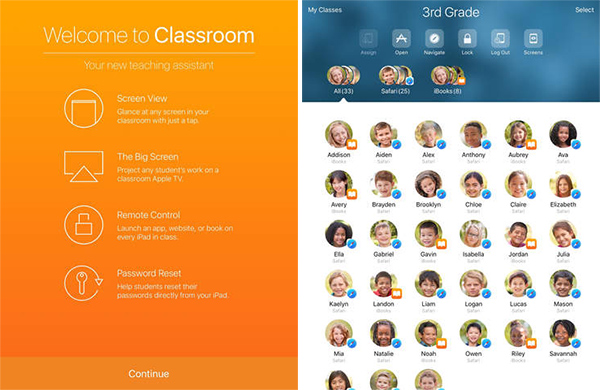Ten years after Apple launched iTunes U, the giants of the Internet are getting education professionals involved in a large-scale digital transition with their new “Classrooms”, which are actual online toolboxes aimed at teachers, students, parents, and headmasters. If you have never heard of these app packages, here’s an overview of their features.

Educational activity creation, schedule management, work monitoring, exchanges between teachers and students, information for parents, administration management tools, and mobile device management: for the last few years Microsoft, Google and Apple’s education teams have been developing increasingly comprehensive apps to improve learning document flow.
Google Classroom: education’s ”All-in-One’’ solution
To access it, a G Suite for Education account is required, which is provided by schools. Created two years ago, Google Classroom is a complementary solution to Google’s mailbox (Gmail) and cloud storage service (Drive), and is available on all major browsers. A mobile version is also available, with limited functionalities, on Android and iOS.
What can we do with Google Classroom? Teachers are able to:
- Create classrooms, teachers’ meetings, media-enriched documents for the students, multiple-choice questions, and schedules for each class or work group
- Plan their publication and monitor each student’s activity
- Centralise educational resources, table-based assessments, etc.
From their Drive account, students work on documents in their own or in groups, share resources and exchange with their classmates and teachers.
For the start of the 2016 school year, Google had introduced several major new features to their Classroom app: annotations and assessments directly on a document from both computers and mobile devices, monitoring of educational activities and homework by parents via email. All the new features are listed here.
Microsoft Classroom under test in the US, and soon in Europe?
The app platform was unveiled in the spring of 2016 by Microsoft, to develop the Office 365 Education ecosystem. Much like their competitor Google, Microsoft is encouraging teachers and students to cross-work on several apps but in the same environment.
Microsoft’s Classroom is built on the powerful notepad OneNote for creating and exchanging documents and comments, the Outlook calendar for homework monitoring, Office apps, creating multiple-choice questions and real-time document editing. The OneDrive storage service is also a key element but it’s still possible to work offline on the Microsoft Classroom mobile app, available on iOS and Android.
Microsoft Classroom is free for Office 365 Education users, but only in the US for now, the full European version will be available later in 2017.
Apple’s Classroom: in-class iPad management
The iTunes U platform will celebrate its 10th anniversary in May, and is the pioneer of educational content sharing services. Since 2007, this service has greatly improved its features: interactive, customised class creation, handing in papers, PDF annotations, private discussions, embedded notepad, contributor invitations, etc.

With “Classroom”, which was launched in 2016, Apple takes it to the next level to help teachers manage in-class iPad sharing themselves. Thanks to this new app, teachers can connect the students equipped with tablets, grant them access to apps, websites, online documents, monitor what they do on the tablet, and potentially lock access to refocus the work group.
















